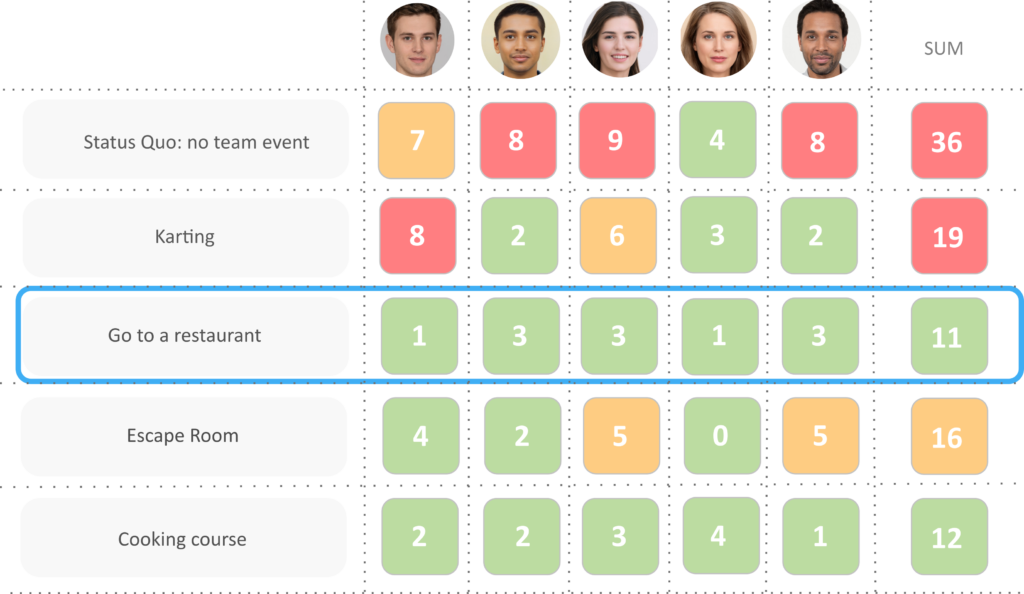Systemic consensing is an effective group-decision making process to reach the best possible consensus[1] on a solution. With this method, it is possible to make the best use of collective intelligence and reach a strong agreement from the group. As a consequence the decision has better quality, and there are significantly more chances that the it will be implemented.
The process is based on group voting but is open to new propositions and enables a quick convergence to a solution with the best agreement.
How it works?
The core of this method is the resistance assessment of participants in a matrix. This matrix is filled out by the participants and discussed with the group in the following steps.

Step 1 – Brainstorming
Like for other decision-making methods based on voting, it is important to have first a good brainstorming of possible options. According to research [2], brainstorming is more effective when it is done on an individual basis and aggregated rather than done in the group.
In case you have to decide about a change, adding the passive option or “status quo” as an option has two main advantages: First you can better assess the option quality, as you can compare the adoption compared to the status quo. Secondly it makes clear why a change is required. So it is generally a good idea to request the team to assess the passive option.
Step 2 – Resistance Assessment
Request the participants to assess their individual resistance for each option. Each participant is evaluating between 0 and 10 the pain level he would have with the proposed solutions.
The assessment of the pain level has to be a fair evaluation, that’s why the maximum value 10 has to be chosen only when the pain is intolerable. Request participants to vote more than 5 if they start having concerns about the option. To avoid the anchor effect, prefer anonymous voting.
Step 3 – Discussion
When all participants have voted, you can show the matrix to the group. The evaluations form a matrix which shows the options with the total resistance from the group. The solution with the best agreement is the one with the lowest sum of resistances.
Check if there are concerns (resistance higher than 5) and request to explain them. It is very important to have all important objections covered, to be able to improve the proposed solutions.
Step 4 – Solution refinement
If you have at least one objection, give the team some time to think about improvements and propose new options by asking the question “what can we change in this proposal to lower the resistance to it? After you have new proposals, you can request the team to vote again for the new options.
For the decision process you define in advance a maximum individual resistance or veto option. For instance you would agree that an option cannot be accepted until there is an individual resistance of 7, and request the team to make more proposals until there is no such resistance.
Comparing systemic consensing with consent
In the consent decision making, the group selects a solution when nobody has expressed a valid objection. This is very good to reach an agreement quickly, but some people may be stressed by having to react immediately to the proposal, and don’t express their concerns as they do not know what a valid objection is. The consent is good for the “safe enough to try” (SETT) options, where there is no big risk and the group has sufficient maturity to stick to the decisions.
In the systemic consensus instead, there is a better transparency of opinions from the group about the different options, and therefore the agreement for the decision is generally better than for the consent decision making. So you can use this method when the impact the decision is high and you need a strong agreement from the group.
When to use systemic consensing?
Use the method when you need transparency about concerns in a group and you need strong agreement. The number of refinement rounds depends on the decision quality you want to reach.
Strategic decisions
This method is very well suited for strategic decision making. By exposing the different strategy options and assessing resistances to them, you can quickly remove concerns and converge to a strong agreement from the group.
Recruiting process
Systemic consensing may be used in your recruiting process. After the interviews, let each team member assess their concerns about the different candidates. The team has then the opportunity to exchange their analysis of the interviews. Add the option to interview other candidates, to make clear when no candidate is suited for the team.
Product design
In the product design, the systemic consensing may be used to get feedback about different product options. Each stakeholder has then the opportunity to articulate concerns and the group can use creativity to lower the overall resistance for the proposed design options.
Conclusion
Systemic consensic is an excellent method to make use of the collective intelligence and reach a strong agreement from a group. Therefore it is a must in every facilitator toolbox.
References
[1] https://en.wikipedia.org/wiki/Consensus_decision-making
[2] Group versus individual performance: Are N+1 heads better than one? G. Hill. Psychological bulletin 91 (3): 517-539 (1982)

